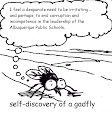When will you again?
 I will read a petition of sorts,
I will read a petition of sorts,
at public forum tonight.
I will read it in the form of a motion.
It is your Constitutionally
protected human right to stand up in support of that motion. And by that I mean literally stand up to be counted.
Know that if you do stand up in support of the petition, you will be standing up in violation of School Board Rules of Decorum for school board meetings.
The consequences could include being removed from the meeting upon the order of the board and by their publicly funded private police force.
 |
| It takes a preliminary injunction from a federal district court judge to stop their Praetorian Guard from ejecting peaceful poster holders from open meetings. |
That said, the motion and me, because I will stand up at public forum to read it, should be part of the discourse around the election of new school board members and the hiring of the next superintendent.
Your real "risk and sacrifice" should you decide to stand up are; you can't really take back standing up, and you will have to get yourself to the John Milne Community Board Room in time for public forum. The meeting starts at 5; the public forum usually follows within a half hour or so.
People have taken greater risks and sacrificed more profoundly surely, in support of your Constitutionally protected human rights to freely assemble, speak freely, and petition your government.
What better way to protect your rights than to exercise them freely? What better way to say thank you to those whose sacrifices enable you, than by exercising them often?
A motion in support of community member seats on the APS District and Community Relations Committee.
- Whereas the Albuquerque Public Schools Board of Education Code of Ethics calls for the establishment of open and honest two-way communication between the leadership of the APS and the communities and community members they serve, and
- Whereas there is no regular venue where communities and community members can engage in open and honest two-way communication between the leadership of the APS and those communities and community members, and
- Whereas participatory decision making including constructive study, discussion, and active participation by citizens is in the best interests of students and the best program of education in the community.
There will be created on the District and Community Relations Committee, seats for communities and community members in order that they may participate as equals in the consideration of the disposition of their interests in the public schools*.However it is organized, there will be stumbling blocks, not the least of which is;
*The framework of which will decided during their very first meetings.
One of the primary risks in any participative decision-making or power-sharing process is that the desire on the part the school board and superintendent for more inclusive participation is not genuine.Because it is easy to mislead people into thinking they are making decisions when in truth the decision and the decision makers are already decided.
"There is a critical difference between going through the empty ritual of participation and having the real power needed to affect the outcome of the process". Arnstein
Participation without redistribution of power is an empty and frustrating process for the powerless. It allows the power holders to claim that all sides were considered, but makes it possible for only some of those sides to benefit.I hope we will agree and decide that;
- The basic concept is a power-sharing arrangement in which decision making influence is shared among individuals who are otherwise hierarchically unequal.
- Each committee member has an opportunity to share their perspectives, voice their ideas and tap their skills to improve team effectiveness and efficiency.
- Participatory decision-making will ensure a completeness of decision-making and increase community and community member commitment to final decisions.
- Participative decision-making will encourage communities and community members to participate meaningfully in organizational decision-making. It will create a sense of belonging to the organization. It will increase morale.
- The conversation will be impartially facilitated in order to synthesize all the available information into the best possible decision.
Will you support a motion to create communities and community members seats at a roundtable discussions with the leadership of the APS as a part of District and Community Relations Committee meetings?Any answer except yes, means no.
photos Mark Bralley

No comments:
Post a Comment